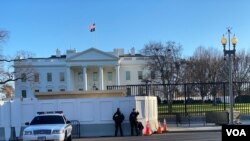President Donald Trump is finally getting a bigger, stronger barrier, but it’s not along the southern border with Mexico.
The White House fence is in the process of being replaced under the direction of the U.S. Secret Service and the National Park Service. The move comes after a series of security breaches over the years, including a 2014 incident when a Texas man scaled the fence and made it into the White House before being stopped.
These days, a temporary white barrier shields tourists’ iconic view of the White House thanks to the ongoing installation of a new fence.
The first part of the replacement barrier is already up. At 13 feet tall, it’s almost double the current 6-feet 6-inch tall fence. The posts are thicker and stronger, and incorporate anti-climb and anti-intrusion technology.
“Almost doubling the size of the fence and give it some kind of blast and ram protection. So everything, all the pieces, had to be beefed up,” says Thomas Luebke, secretary of the U.S. Commission of Fine Arts, the federal design review board for Washington, which advised the Secret Service and Park Service on the aesthetics of the fence design.
The new enclosure is a far cry from the very first White House fence, which was made of wood and erected by Thomas Jefferson in the early 1800s. A few years later, he replaced the wooden fence with a stone wall. By 1819, portions of the fence were made of iron. Sections of today’s fence date back to around 1830.
The early fences were designed to keep out animals, not people. Visitors often freely roamed the White House grounds.
“It was relatively easy to get inside and go upstairs to the second floor. That's where the president worked before the West Wing was built,” says Matthew Costello of the White House Historical Association. “So, you can imagine the president trying to get work done and just being besieged by office seekers, lobbyists, all types of people who would essentially stand out in the hallway and hope to get a quick meeting with the president or catch a glimpse of the president.”
President Abraham Lincoln had a doorway cut between his office and the residence so that he could avoid the crowds waiting outside his office door.
Up until the 1920s, presidents determined how accessible to keep the grounds. In the 1880s, President Grover Cleveland kept an open-door policy, until strangers tried to pick up his children. President Theodore Roosevelt decided to reopen the White House grounds in the early 1900s, but changed his mind when people kept wandering over to the West Wing to catch a glimpse of him.
All of the presidents up until John Tyler in the 1840s used their own staff to guard the White House. However, the U.S. Secret Service ultimately took control of security after three sitting presidents were killed during a 36-year period between 1865 and 1901.
“Between Abraham Lincoln's assassination, James Garfield’s assassination, William McKinley’s assassination, if you had been born in 1840, over the course of your lifetime, you would witness three presidential assassinations,” says Costello.
WATCH VIDEO:
It was during the administration of President Calvin Coolidge in the 1920s when the White House grounds were closed for good to wandering strangers, tourists and visitors. Since that time, visitors have needed an appointment to visit the executive mansion.
For this latest incarnation of the White House fence, the U.S. Commission of Fine Arts worked to help balance security improvements to the new fence while keeping the barrier visually appealing.
“The question is you just can't just take the old design and double it. You actually have to start rethinking the pieces, what they're made of, how well they work together,” says Luebke. “Trying to get the proportions right. Which material goes where? What kind of finish?”
Construction on the new enclosure is expected to end in 2021. And then, attention might turn to an overall design for the rest of the complex, a plan that takes both security and aesthetics into account.
“So, they can pull together what's really right now a bit of a hodgepodge,” says Luebke. “The installation of what they've got right now has been done piecemeal and sort of often, sort of quickly, without much thought.”
A comprehensive plan would put in place lines of defense that don’t ruin Washington’s most iconic views.








